Waterproof sockets: overview of possibilities, where to use and how to choose
The electrical fittings market now amazes with the abundance of electrical installation products that can work perfectly under specific operating conditions. Among such proposals are waterproof sockets. You should familiarize yourself with their advantages and features before purchasing. Do you agree?
We offer reliable information about the specifics of the design and operation of sockets for rooms with high and unstable humidity levels. Here you will learn how to select a device according to the degree of protection, how to read the product labeling. We will introduce you to the leading manufacturers in the segment.
A detailed description of sockets for operation in conditions of direct and indirect contact with water is supplemented with diagrams, a selection of photo illustrations, a video presentation and installation instructions.
The content of the article:
Classification of electrical outlets
The socket is a standardized plug connector for connecting household tools and appliances, industrial installations and machines.
To get it right pick up a socket for a room, you need to have at least a basic understanding of the types of sockets and take into account several factors when selecting sockets for rooms.
Experts in the field of electrical wiring distinguish a large number of types and types of socket products, which can be grouped into several classes:
- By mounting type. They are divided into overhead and hidden. The former are actively used in auxiliary, utility and industrial premises. They are used when installing retro wiring in cottages made of timber or logs.The latter are installed in spaces where the main focus is on the interior, namely the absence of any protruding elements on the walls of residential premises.
- By the number of connectors in the socket panel. The most common products are with one, two and three connectors. There are products with four or more connectors. The number of simultaneously connected and operating devices in the room depends on this.
- By type of plug connector. To divide into typical groups, markings in Latin letters are used. In the countries of the post-Soviet space, C, E and F are in use. Although in the world there are at least 13 different socket plugs, and corresponding sockets for them.
Speaking about related factors, it is also necessary to remember the voltage of the power supply network into which we install the outlet: 220 or 380 V. 220 V is used for household appliances, and 380 V is often used to power all kinds of installations, machines, machines, etc.

During the selection process, you can pay attention to the color palette of the finished product and especially pay attention to the manufacturer. We strongly do not recommend buying cheap sockets - this indicates the presence of cheap materials in the design, which directly affects the safety and reliability of the product.
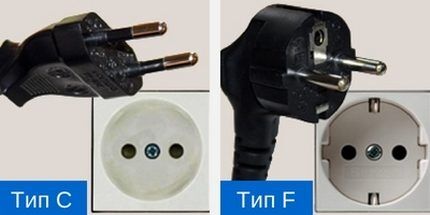
Features of waterproof devices
As noted above, the electrical fittings market is represented by a wide range of socket products that meet almost all technical requirements and even protection from moisture and dust.
Such sockets have a special design: a durable housing, a protective valve-cover, an insulated terminal block, a contact group and necessarily grounding.
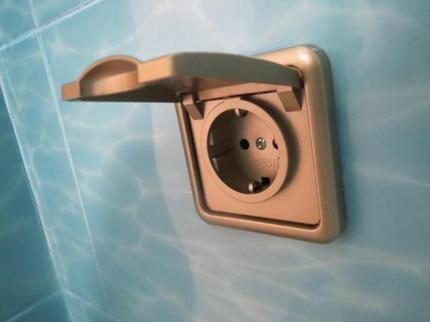
The cases and covers of such sockets are made of special polymer heavy-duty plastics that can withstand moisture and low temperatures. The terminal block can also be made of plastic or high-strength ceramic.
The contact group and grounding “petals” are made of alloyed steel and brass alloys, which allows for a reliable and safe connection of contacts with the plug connector of an electrical device.
This corrosion-resistant product is capable of operating in the most extreme weather conditions, with direct contact of drops and jets of water.
A typical moisture-resistant socket has a different form factor; in most cases, it includes a recess in the housing for the plug and a protective cover. The recess protects the socket from the lateral influence of water, and the cover protects from direct moisture entering the socket openings.

And yet, the housing and cover of the socket protect the terminal block from dust and other abrasive particles that can negatively affect the condition of the electrical contact between the power supply network and the electrical device.
To compare the degree of protection from moisture and dust relative to the shell of a certain product, the so-called parameter is used - Ingress Protection (IP).
Shell protection degree
Protection of the shell or housing of any device that contains electrical parts/elements is one of the main characteristics of the finished product in accordance with international standards IEC60529 (DIN40050, GOST 14254).
In any case, every household electrical appliance and industrial equipment must have a certain degree of enclosure protection, which is determined by the standardized 4-character IPXX code, where:
- IP stands for the very concept of equipment protection level;
- the first numeric character X sets the degree of protection against the penetration of dust and particles;
- the second numeric character X sets the degree of protection against penetration of moisture and water.
In addition, in the equipment marking there is another additional letter symbol, which indicates the degree of protection of a person from access to dangerous parts and parts of the same equipment. But it is not used for waterproof sockets.
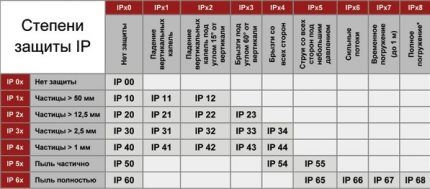
For the first numeric character we have 7 levels of protection:
- 0—no protection;
- 1-4 - protection from large bodies (pieces of wire, parts of cable, insulation residues, nuts, washers, bolts) and organic particles (stones, earth, sand) with a diameter of over 1 mm;
- 5 - protection from dust, there is a possibility of particles entering the device, which does not interfere with its normal operation;
- 6 - protection from dust, particles do not penetrate inside the device.
For the second numeric symbol we have 9 levels of protection, but we are only interested in options from 3 to 6:
- 3 and 4 - protection against splashes and raindrops;
- 5 - protection from water jets, which does not interfere with its normal operation;
- 6 - protection from a strong water jet, which does not interfere with its normal operation.
For moisture-resistant sockets that are installed indoors, there are several typical enclosure ratings, such as IP44 or IP45.
For outdoor moisture-resistant open type sockets - IP54/55, but the most common and widely used are IP65/66 class markings, which are recommended to be purchased for external use.
Using moisture-proof sockets
There are practically no questions about the use of ordinary sockets - we put them where they are needed.
But a waterproof socket is another matter - a special class of sockets that are used in special cases, namely:
- bathrooms and bathrooms of apartments (houses);
- cosmetology centers and fitness clubs, where water treatments, saunas, baths, steam rooms, showers are provided;
- swimming pools and entertainment centers such as dolphinariums, water parks, etc.;
- “street” use (on the outside of buildings) and at industrial facilities.
The bathroom of a classic apartment has long ceased to be an archaic room with only a washbasin and a cast-iron bathtub; now it is a high-tech room in which washing machines, hydromassages, Jacuzzis, boilers, electric hoods and dryers are installed.
Don’t forget about the need for an outlet for a hair dryer, curling iron, electric razor and much more. The bathroom also needs such basic things as an electric hood and a hand dryer after washing. All this “good” must be powered from a reliable source - the electrical network through a waterproof outlet.
Today's beauty salons and sports and fitness clubs provide more than a wide range of cosmetic and health services, which include water treatments.
To safely provide such services, moisture-resistant sockets are used, into which an extensive list of electrical appliances and equipment is connected: from a dryer to a tubular electric heater (heating element) for “heating” the stones in the sauna.
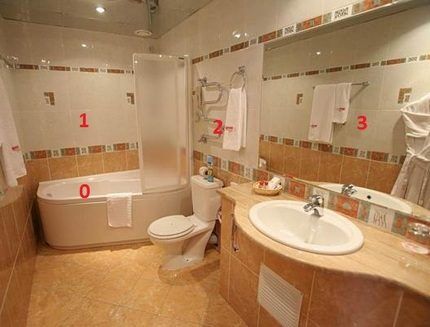
There is no need to talk about the need for moisture-resistant outlets in a swimming pool or water park. It is impossible to normally, and most importantly safely, turn on any water ring pump or other injection unit to ensure water circulation in the tank or the presence of the required water flow force on the attraction.
A huge amount of industrial equipment operates from the electrical network in the most extreme environmental weather conditions or with the presence of liquid inside the unit.
In order to eliminate the systematic or accidental negative impact of moisture on the electrical connection between the power supply and equipment, waterproof sockets with the maximum protection class of the shell are used everywhere.
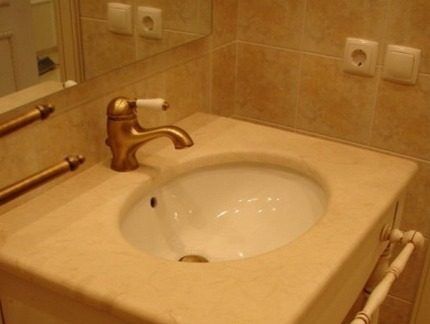
General safety rules
It is clear that for the safe use of household appliances and auxiliary equipment, you need to follow trivial safety rules when connecting or disconnecting an electrical appliance to an outlet.
For example, before plugging the plug into the socket, inspect the cavity of the socket connector and make sure that there are no foreign objects in the socket, and that there are no fumes and “dark” spots on the surface of the socket and near it on the surface of the wall where it is installed.
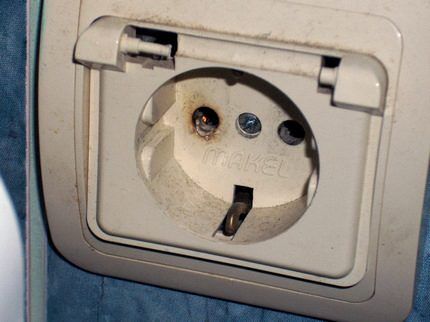
Next, inspect the wire of the electrical appliance itself and the plug, check for the absence of exposed parts of the wire and darkening on the cable. If the above factors are detected, stop using this electrical appliance and call a specialist. Or check the fault yourself if you have the appropriate skills.
When disconnecting the plug from the socket, it is recommended to hold the surface of the outer panel of the socket with your free hand and smoothly pull the plug out of the socket. If you sharply “pull” the plug from the socket, you can “rip” the terminal block from the socket.
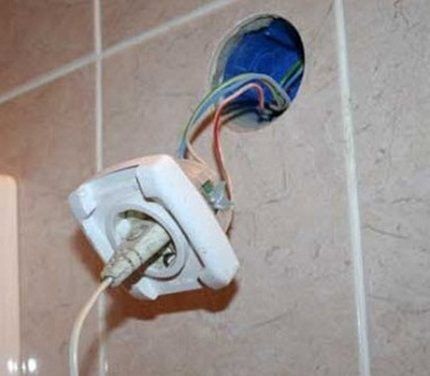
Everyone knows that water is an excellent substance for transmitting electrical charge, therefore it is necessary to avoid any contact of moisture with the conductive element of the network, which is the socket. Although the outlet itself is protected from moisture, this does not mean that electricity cannot affect human health.
If you find water near the outlet, we strongly recommend that you completely turn off the power supply in the entire room, for example, at the distribution brush, and call a specialist.
Guidelines for choosing a bathroom device
Let's go directly to the selection algorithm itself and installation of moisture-resistant socketsfor our bathroom. As already noted, the classic modern bathroom is a room where a sufficient number of electrical appliances and devices are concentrated.
In order not to make a mistake in choosing an electrical installation product, you should consider:
- Socket protection class. The minimum is IPX4 class, optimally IPX5 or IPX6 class, it is not rational to buy anything equal to or greater than 7.
- Design, color and shape. As they say: “There are no comrades according to taste.” When choosing a socket for the bathroom, you need to take into account the size, shape, presence of a cover, back panel, etc., in order to harmoniously fit the product into the overall ambiance of the room.
- Number of connectors. The standard is the use of two multi-block socket connectors. One is used to connect large equipment (an automatic washing machine, hydromassage and other water therapy systems), the second is used for “small” electrical household appliances (hair dryer, razor, dryer, extractor hood, additional room lighting).
- Separate machine. When installing moisture-resistant sockets in the bathroom, you need to provide a separate power supply line for them. In addition, connect all these outlets through the emergency shutdown unit in the distribution panel. Sockets must be grounded.
There are also special requirements for electrical wiring. The material of the power cables is copper; cable laying in the wall is only possible if there is a special PVC box.
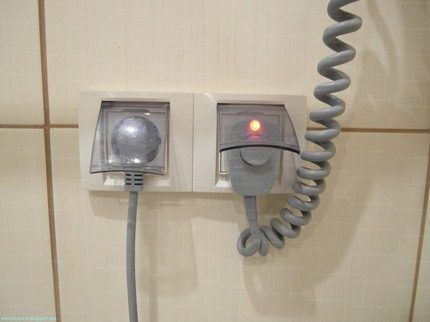
It is worth noting that the above reasoning can be easily applied to the selection and installation of waterproof sockets in utility rooms of a private house, basement storage, garages, etc. You can only exclude the requirement of design and “beauty” in relation to the external decorative panel of the outlet.
Sockets for outdoor use
If you are the owner of a private house, a country estate, or an ordinary 6-acre plot of land with a trailer, then there is no need to talk about the variety of situations when you need a simple outlet “at hand.” In order to avoid purchasing 100-meter extension cords, it is rational to install the required number of sockets on the outside of any object.
Waterproof socket blocks can be installed almost anywhere: the wall of a building, on a wooden support for a gazebo, on the “deck” of a mini-pool, inside a stone/brick fence support, on the outside of a wall in a garage or other utility room.
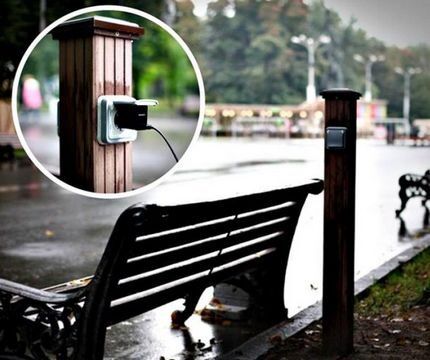
These sockets can easily be used to connect virtually any electric tool or special equipment, which is more economical in terms of energy consumption compared to devices powered by gasoline and diesel engines.
For example, we plug in an electric saw, electric pruning shears, an electric barbecue and a stove, submersible pump and a pressure water/air compressor. Let's move on to passive relaxation - we can easily connect an external audio system, a television panel and much more to such sockets.
Regardless of the purpose of using the “street” outlet, we recommend adhering to some notes on the choice of location and method of mounting the electrical connector:
- It is advisable to install the socket under any ledge or visor;
- height from the ground surface at least 75-80 cm (taking into account the possible level of snow cover);
- the cable for the socket must be with protective grounding;
- connecting the wire to the socket exclusively from below - this will prevent draining water from getting inside the electrical equipment.
Protective membranes must be provided inside the socket, and the contact group must be made of bronze or some copper alloy. This “outdoor” moisture-resistant outlet is integrated into individual bag - this will protect the rest of the power supply network in the event of a fault.
Conclusions and useful video on the topic
A worthy example of the correct selection and installation of a waterproof double socket with correct connection to a separate circuit breaker:
The following video is presented solely as an introduction to advanced technologies in the field of electrical wiring components:
Finished products from popular manufacturing companies LEGRAND, SCHNEIDER ELECTRIC and BERKER have excellent characteristics of strength, reliability and safety.
It is also possible to purchase fittings from the Swedish ABB and the German GIRA, but these companies cost a little more due to the use of rather expensive materials in the production of products, including bronze and gold-plated metals.
We are waiting for your stories about choosing sockets for installation in bathrooms and swimming pools. Please write in the block located below, under the text of the article. Here, ask questions and comment on the material offered for review.




A very convenient and virtually irreplaceable thing in the bathroom. Just buy products from a reliable brand.I once purchased and installed waterproof sockets from a cheap manufacturer. So at first it began to burn and melt, as it could not withstand the load. And when I wanted to disassemble it to establish the cause, at first it fell out with the fastenings, and when I tried to disassemble it, it began to crumble into pieces.
I added a bathroom to the house, combined with a toilet and shower. I went to a construction hypermarket to get sockets. I was advised to use waterproof sockets from Gusi Electric. I liked both the design and the quality of this electrical product. I took it with a hidden installation. They look beautiful, they chose a metallic color. The lid does not fall off when opening, which is very convenient. And so, it’s closed and in order, no moisture will get in, no child’s curious nose.
Waterproof sockets, of course, are used in places of high humidity. I even installed these in my house, although my humidity level is fine. But there is always a risk of accidental ingress of water, so it is better to install such sockets always and everywhere. What I like about them is the appearance and, in fact, the waterproofing protection itself. But despite the fact that they prevent water from entering the electrical part, it is still necessary to adhere to the rules for using sockets and not neglect safety.
What's the point of overpaying and putting them everywhere? This is a specialized item for the bathroom/pool/bath.